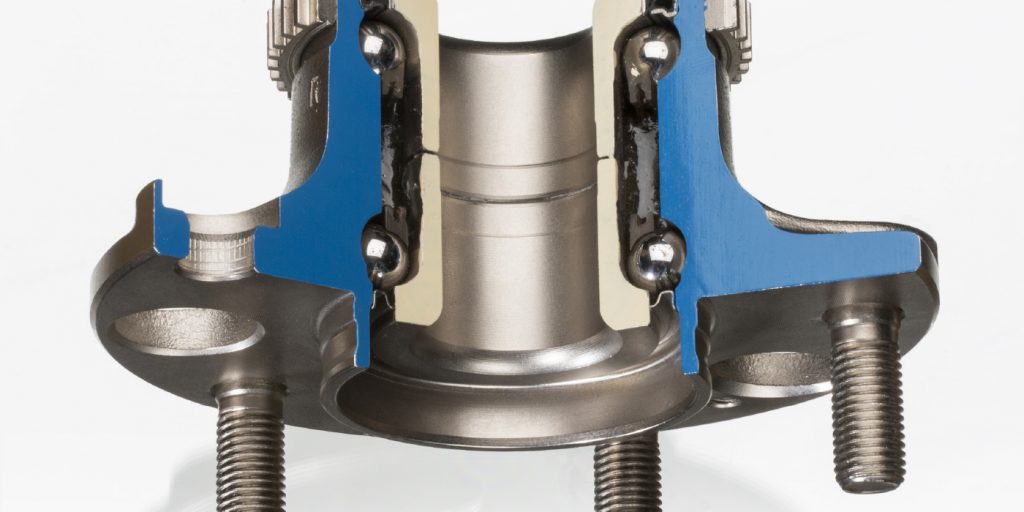The longer you work on cars, the more you see trends with wheel bearings. Older rear-wheel-drive cars and trucks almost exclusively had adjustable tapered roller bearings in the front with angular contact bearing inside a solid axle at the rear.
Front-wheel drive changed everything. In the chaos of the early 1980s, captured wheel bearings, hub units and cartridge wheel bearing designs came on a wide variety of vehicles.
In the early 2000s, it felt like the sealed hub unit was going to be the standard. But Ford, Volkswagen and Toyota started to use cartridge wheel bearing designs on most of their popular platforms. Now it feels like the hub unit is making a comeback.

Regardless of how the bearing is packaged or designed, all bearing rolling elements are protected by seals. Eventually, the seals fail and/or the surfaces of the rolling elements become damaged.
When any bearing fails, it is usually a case of inadequate lubrication. Internal or external forces can cause the failure of the lubricant. Internally, the bearing surfaces could be damaged by an impact. As the damaged area grows due to spalling or brinelling, the grease inside the bearing exceeds the maximum temperature. When the grease is heated, it oxidizes, and its lubricating properties are lost. Externally, when the seal fails, it causes a loss of lubrication, and the grease inside might becomes contaminated. The knockout punch comes when the bearing overheats, and the remaining lubricant becomes oxidized.
Understanding why a bearing failed is important because it might not be the fault of the bearing. Bearing damage could be inevitable if the customer overloads the vehicle. The most common failure pattern for bearings is for those on the passenger side of the vehicle to fail first. The passenger-side bearings are exposed to the most roadside standing water. If the bearings on the driver’s side of the vehicle fail first, take an extremely close look at the passenger-side bearings, as their failure may not be far behind.
Torque To Spec
The modern suspension is a mixture of stamped steel, cast iron and aluminum. Even those common materials can have different properties depending on if they were forged, hydro-formed, or even welded. This marriage of materials requires different fastener technology and torque procedures.
If you are installing a hub unit on an aluminum knuckle, you need to look up the torque specs. There is a strong possibility the bolts are torque-to-yield (TTY). The advantage of TTY fasteners is that they use less space, and the clamping force remains consistent. Also, TTY fasteners can be holding together components that might have limited space.
Even if the fastener is conventional, you still need to look up the torque specification. The other thing to look at is thread locking compound – thread lockers aren’t all the same. The type of thread locker required depends on the finish, size and strength requirements of the fastener. Newer vehicles use yellow and green thread lockers that work well with coatings on the fasteners and components to increase abrasion resistance. These coatings are not compatible with some traditional blue and red thread lockers.
The good news about torque specification is that more have the pre-load set at the factory through a process called orbital forming. This process cold presses the inboard flange and inner race so the bearing is pre-loaded.
New Designs
Cars and trucks are changing. It is now common to see stock wheels that are 19- or 20-inches in diameter. This reduces the amount of tire sidewall that can be used to absorb impact to the bearings. Larger rims can also put more cornering force on the wheel bearings. Engineers can increase the size wheel bearings to counteract the forces, but larger diameter bearings increase the rolling resistance due to more rolling elements and a larger seals.
If engineers can’t increase the diameter of the wheel bearings, they can improve on the existing design. Two examples of how engineers are changing wheel bearings are the face (axial) spline and asymmetric hub units.
The latest hub design moves the splines from inside the bearing races to the back of the hub. Axial- or face-spline hubs have what look like gear teeth on the backside of the hub assembly unit. Matching axial gear teeth are formed on the end of the CV joint, and the whole unit is held in place with a long bolt.
The axial-spline arrangement allows higher torque transmission than the traditional splined CV method, primarily because the gear teeth operate on a much larger pitch circle. This design allows for a smaller diameter hole in the center that can improve the stiffness of the bearing and its durability. It also can reduce brake pedal pulsation and travel. These units come preassembled and pre-loaded from the manufacturer. The pre-load is set by cold rolling the inner race under many tons of pressure.
Asymmetrical wheel bearing hubs use different bearing row diameters to improve load capacity and overall stiffness. The hub’s outboard row has a larger diameter than the inner row and more rollers or balls. Hybrid asymmetrical designs use both rollers and ball bearings in the
two rows.
The design increases the bearing load capacity and the unit is stiffer than a conventional hub of the same size. This stiffness prevents the brake rotor from flexing and tilting while the vehicle is cornering, and reduces brake caliper piston knock back that can cause a long brake pedal.
Back in the day, most wheel bearings could be replaced on pure intuition. Today, new designs make it mandatory that you look up the service information. If you go on intuition and your calibrated elbow, you might make a costly mistake.














